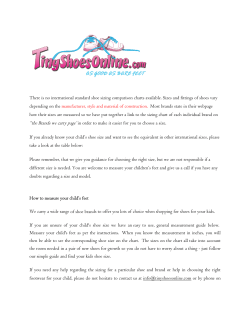
U Relieve Metatarsalgia Foot Pain Today!
July 2013 Page 9 Relieve Metatarsalgia Foot Pain Today! By Dr. John Sigle, DPM, FACFAS, Foot & Ankle Center of Illinois U nlike most Americans who cannot wait to come home at night and kick off their shoes, some people with Metatarsalgia actually experience more pain when they walk in their socks or bare feet. Metatarsalgia is condition characterized by a sharp aching or burning pain and inflammation in the ball of the foot. It affects the metatarsal heads, the bones that make up the ball of the foot. The first metatarsal head behind the big toe is the most common area affected but it can also affect the other toes, the entire foot, or both feet. Other symptoms include tingling or numbness in the toes, pain around the second, third, and fourth toes or only near the big toe, increased pain when you walk, run, or jump, or when you stand or flex your feet. Patients with this condition often feel like they have a stone in their shoe or that their socks are wadded up causing them to walk on the side of their foot to avoid pressure. It commonly presents as one or multiple calluses on the ball of the foot and can also be mistaken for a plantar wart. Prominent Metatarsal heads cause these to form. Metatarsalgia can affect males and females of all ages. It is primarily related to repetitive stress and impacts on the foot, and often experienced by people who participate in intense physical activities or training such as running, tennis, soccer, and basketball. Metatarsalgia generally occurs from a single cause but other factors that may contribute to this condition. These include wearing ill-fitted shoes (high heels), having certain foot and toe shapes (high arches, a second toe that is longer than the first metatarsal), being over-weight, or old age. It can also be attributed to a stress fracture or other foot deformities like a hammer toe or bunion, or from Morton’s Neuroma (a fibrous tissue around a nerve between two metatarsal heads), diabetes, Rheumatoid arthritis, fluid in the foot, and gout. There are a variety of home remedies that should be tried prior to contacting your physician or podiatrist. Some of the things that can be done include wearing proper fitting shoes indoors and outdoors, avoiding pressure and impact loads, resting your feet and keeping them elevated, applying ice throughout the day, taking anti-inflammatory drugs (such as ibuprofen), using metatarsal pads, sock absorption pads, or arch supports. If your pain persists for a month or so, schedule an appointment with your podiatrist for a diagnosis and proper treatment. There are a variety of problems that can cause symptoms similar to Metatarsalgia. Most likely it will be necessary to do a gait analysis to identify the parts of the foot are receiving pressure, image tests (Xray or MRI) or ultra sound to confirm if there are fractures, or if the problem is related to a metatarsal drop or improper length. Imaging will also help your doctor determine if the pain is being caused by a Morton’s Neuroma. Blood tests may also be necessary to rule out gout, diabetes, or arthritis. Your podiatrist may also be able to offer you a custom orthotic device to alter the pressure distribution of the metatarsal region and relieve inflammation and pain. An orthotic device can be added to all shoe types (except sandals) and will be particularly helpful for running and athletic shoes. Orthotics is also well-suited for individuals who have a high arch because it can prevent the arch from collapsing and relive stress on the metatarsals. Orthotics is also effective for people with a Morton’s Neuroma because it provides an extension underneath the big toe. Laser therapy is the latest advancement that is being used for patients in the acute phase of Metatarsalgia. The lasers are designed to reduce pain, relieve inflammation, and restore mobility. These lasers use specific wavelengths of light that have a strong anti-inflammatory, anti-edema effect on tissues. Photons of laser energy penetrate deeply into tissue and accelerate cellular reproduction and growth, thereby speeding recovery. Painful conditions accompanied by swelling or inflammation benefit from this technology. Once the inflammation subsides, physical therapy may also be used to increase range of motion, reduce stress on the forefoot, and strengthen the toe flexor muscles. For more severe cases where conservative treatment and therapies have failed, steroid injections or surgery may be recommended. Surgery may involve a correction of a hammer toe deformity, release or removal of a nerve impingement, or reshaping of the metatarsal bones. If you are suffering from Metatarsalgia and want relief today, follow some of these home remedies to achieve relief. If your pain persists, contact your podiatrist for a diagnosis and treatment. For more information on Metatarsalgia, laser treatments and custom orthotics, or to find a board-certified foot and ankle surgeon, call Dr. John Sigle at 217-787-2700. The Foot & Ankle Center of Illinois is located at 2921 Montvale Drive, Springfield, IL, 62704. Visit myfootandanklecenter.com to view a short video on Cutting Edge MLS Laser Therapy and to obtain information from the patient education library on these subjects.
© Copyright 2025





















